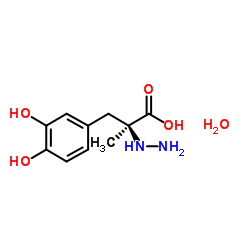38821-49-7
| Name | carbidopa |
|---|---|
| Synonyms |
Benzenepropanoic acid, α-hydrazinyl-3,4-dihydroxy-α-methyl-, (αS)-, hydrate (1:1)
CARBIDOPA 1-HYDRATE,PHARMA Carbidopa (S)-Carbidopa 1-a-(3,4-Dihydroxybenzyl)-a-hydrazinopropionic Acid L-a-Methyldopahydrazine (aS)-a-Hydrazino-3,4-dihydroxy-a-methylbenzenepropanoic Acid CARBIDOPA MONOHYDRATE (S)-(-)-CARBIDOPA MONOHYDRATE a-Methyldopahydrazine Lodosin carbidopa [INN_en] CARBIDOPA HYDRATE CARBIDOPA(GMP CERTIFICATE) (S)-(-)-Carbidopa HMD CARBIDOPA,USP (2S)-3-(3,4-Dihydroxyphenyl)-2-hydrazino-2-methylpropanoic acid hydrate (1:1) (2S)-3-(3,4-Dihydroxyphenyl)-2-hydrazino-2-methylpropanoic acid S-(−)-Carbidopa (S)-3-(3,4-Dihydroxyphenyl)-2-hydrazino-2-methylpropionic acid monohydrate CARBIDOPA 1-HYDRATE (2S)-3-(3,4-dihydroxyphenyl)-2-hydrazinyl-2-methylpropanoic acid hydrate (1:1) MFCD00889211 lodosyn S-(-)-Carbidopa (-)-L-a-Hydrazino-3,4-dihydroxy-a-methylhydrocinnamic Acid (2S)-3-(3,4-dihydroxyphenyl)-2-hydrazinyl-2-methylpropanoic acid Hydrazino-a-methyldopa |
| Description | Carbidopa ((S)-(-)-Carbidopa) monohydrate, a peripheral decarboxylase inhibitor, can be used for the research of Parkinson's disease. Carbidopa monohydrate is a selective aryl hydrocarbon receptor (AhR) modulator. Carbidopa monohydrate inhibits pancreatic cancer cell and tumor growth[1][2]. |
|---|---|
| Related Catalog | |
| In Vitro | Carbidopa ((S)-(-)-Carbidopa) monohydrate exhibits activities similar to that described for other AhR ligands in BχPC3 and Capan-2 cells, namely the induction of CYP1A1 and CYP1A2, which are inhibited by AhR antagonists such as CH223191[1]. Carbidopa, a aromatic-L-amino acid decarboxylase inhibitor, is selectively cytotoxic to human pulmonary carcinoid and small cell lung carcinoma cells. Carbidopa is lethal (IC50=29 μM)[3]. |
| In Vivo | Carbidopa monohydrate also induces nuclear uptake of the AhR, and in vivo studies show that carbidopa at a dose of 1 mg/mouse significantly inhibits tumor growth in athymic nude mice bearing BχPC3 cells as xenografts[1]. |
| References |
| Density | 1.42 g/cm3 |
|---|---|
| Boiling Point | 528.7ºC at 760 mmHg |
| Molecular Formula | C10H16N2O5 |
| Molecular Weight | 244.244 |
| Flash Point | 273.5ºC |
| Exact Mass | 244.105927 |
| PSA | 125.04000 |
| LogP | 0.97380 |
CHEMICAL IDENTIFICATION
HEALTH HAZARD DATAACUTE TOXICITY DATA
|
| Symbol |

GHS07 |
|---|---|
| Signal Word | Warning |
| Hazard Statements | H319 |
| Precautionary Statements | P305 + P351 + P338 |
| RIDADR | NONH for all modes of transport |
| WGK Germany | 3 |
| HS Code | 2932999099 |
| HS Code | 2928000090 |
|---|---|
| Summary | 2928000090 other organic derivatives of hydrazine or of hydroxylamine VAT:17.0% Tax rebate rate:9.0% Supervision conditions:none MFN tariff:6.5% General tariff:20.0% |
